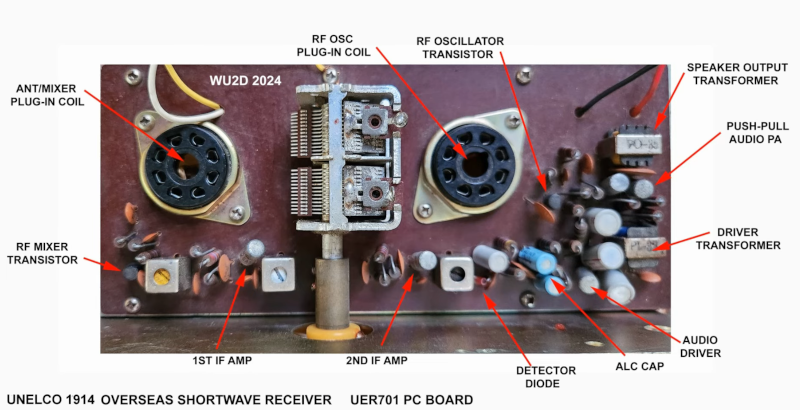[Mikrowave1] had a Unelco shortwave receiver as a kid. This was a typical simple radio for the 1960s using germanium and silicon transistors. It also had plug-in coils you had to insert into sockets depending on the frequency band you wanted to receive.
While simple AM radios were all the rage, they didn’t have to operate at higher frequencies. [Mikrowave1] shows some of the design tricks used to allow the radio to operate in the upper part of the spectrum. Otherwise, the radio is the usual superhet design using lower frequency germanium PNP transistors in the IF stage. You get a look inside the radio and a peek at a similar schematic along with notes on where the radio is different.
But how does it work? For an old single-conversion receiver, it works well enough. Of course, when the radio was new, there were many more interesting stations on shortwave. Today, he had to settle for some ham radio stations and CHU, the Canadian time and frequency station.
There were six pairs of coils built on top of tube sockets. The coil was actually more than a coil. There were other components in the case that adjusted other radio parameters based on the frequency.
[Mikrowave1] has been on a toy kick lately, and we’ve enjoyed it. This radio looks simple compared to the Radio Shack one that every kid wanted in the 1970s. Well. Every hacker kid, at least.















Shortwave resistor?
Well, if you live close to a powerful transmitter…
B^)
Obviously lacked the capacity or was reluctant to proffred.
I guess some people just prefer FM.
Apparently HaD authors don’t have any better editing capability than we do.
Everyone can make mistakes. Only those with editing credentials can cover them up. :)
Fixed the title, thanks.
Superhet? 😟 No BFO? 😢
There is actually quite a bit more still out on the HF bands than amateurs and CHU. There are stations engaged in a battle of wills interfering with each other between Ukraine and Russia; tune around 4 MHz +/-. There are other hot spot frequencies as well. An Internet search will reveal where to hunt for signals. How well you can hear exotic signals depends on where you are and the time of day affecting the D and E layers of the upper atmosphere.
CHU is interesting. The signal has the lower AM sideband suppressed with the carrier possibly reduced in amplitude and upper sideband remaining, so though largely resembling a single-sideband transmission, it can still be received adequately on an AM radio. CHU bucks the convention of using lower sideband single-sideband below 10 MHz snd upper sideband above 10 MHz.
I had this radio (with only one set of coils, couldn’t find others) which was given to me as a Christmas present. It was capable of astounding indoor performance when the antenna was hooked up to the finger stop of a dial phone. At that time (late 1960’s) you literally (yes, literally!) could not move the dial pointer at night without hearing some new foreign station on that band. Those were the days…
I’m loving that ganged tunable air dielectric capacitor. I had one of those when I was a kid.